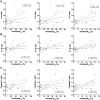Inflammatory biomarkers and pendelluft magnitude in ards patients transitioning from controlled to partial support ventilation
- PMID: 36418386
- PMCID: PMC9684576
- DOI: 10.1038/s41598-022-24412-1
Inflammatory biomarkers and pendelluft magnitude in ards patients transitioning from controlled to partial support ventilation
Abstract
The transition from controlled to partial support ventilation is a challenge in acute respiratory distress syndrome (ARDS) patients due to the risks of patient-self-inflicted lung injury. The magnitude of tidal volume (VT) and intrapulmonary dyssynchrony (pendelluft) are suggested mechanisms of lung injury. We conducted a prospective, observational, physiological study in a tertiary academic intensive care unit. ARDS patients transitioning from controlled to partial support ventilation were included. On these, we evaluated the association between changes in inflammatory biomarkers and esophageal pressure swing (ΔPes), transpulmonary driving pressure (ΔPL), VT, and pendelluft. Pendelluft was defined as the percentage of the tidal volume that moves from the non-dependent to the dependent lung region during inspiration, and its frequency at different thresholds (- 15, - 20 and - 25%) was also registered. Blood concentrations of inflammatory biomarkers (IL-6, IL-8, TNF-α, ANGPT2, RAGE, IL-18, Caspase-1) were measured before (T0) and after 4-h (T4) of partial support ventilation. Pendelluft, ΔPes, ΔPL and VT were recorded. Nine out of twenty-four patients (37.5%) showed a pendelluft mean ≥ 10%. The mean values of ΔPes, ΔPL, and VT were - 8.4 [- 6.7; - 10.2] cmH2O, 15.2 [12.3-16.5] cmH2O and 8.1 [7.3-8.9] m/kg PBW, respectively. Significant associations were observed between the frequency of high-magnitude pendelluft and IL-8, IL-18, and Caspase-1 changes (T0/T4 ratio). These results suggest that the frequency of high magnitude pendelluft may be a potential determinant of inflammatory response related to inspiratory efforts in ARDS patients transitioning to partial support ventilation. Future studies are needed to confirm these results.
© 2022. The Author(s).
Conflict of interest statement
The authors declare no competing interests.
Figures



References
Publication types
MeSH terms
Substances
Grants and funding
LinkOut - more resources
Full Text Sources
Medical
Miscellaneous

